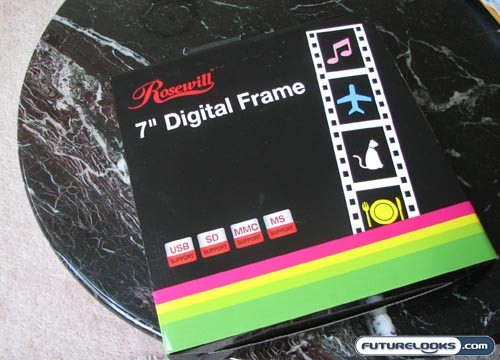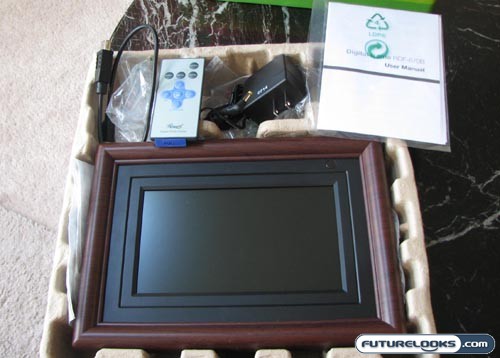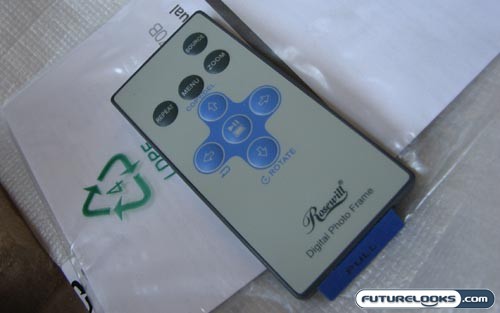I’m not sure if you’ve noticed, but I don’t think any average consumer uses a film-based camera anymore. At the same time, people still seem bent on physical printouts of their digital photographs. Most of which are placed into photo albums and frames for all to see. Things like graduation and wedding photos are particularly popular for this purpose. I find this trend to be quite curious; why would you mix the old school with the new school? If you’ve got digital photos, it only makes sense to display these pictures digitally.

Sure, there are ways to view your photos on the computer. You can upload them to Flickr, email them to family members, or plaster them as a desktop wallpaper. But what about when you actually have guests over in your home? What about when you’re away from the computer? For times like those, there is the Rosewill RDF-670B digital picture frame.
Core Features and Specifications
- 7″ Widescreen LCD With 4MB built in Memory support 20 photos
- Supports SD, MC and Memory Stick Flash Memory Cards up to 2GB
- Built-In Speakers
- Card Style Remote Control
- A/V Input/Output Jack
- Brightness Adjustable
- USB input Jack for Plugging In Your USB Flash Drive(Not for PC or Digital Camera)
- Last Memory Function
- No Distortion
- High Speed Decoding
- Media Auto Gathering and Sorting
- Slideshow Mode
In and Out of the Box
I’m not really sure what it is about the exterior packaging on this particular digital picture frame, but I found it to look quite cheap. I got the impression that it was one of those generic products that no one really wanted, only purchasing it because it was more affordable than a similar product from a bigger name. It’s strange that there is no picture of the actual picture frame on the box. You get a feature list on the back, but without opening the box, you really have no idea what this thing looks like. A simple photo on the front would have gone a long way. The multi-colored stripes near the bottom are pretty kitchy too.

Opening the box, you discover what looks like the cardboard drink tray you get from McDonald’s. Inside this are the Rosewill RDF-670B photo frame, an DC power adapter, a USB adapter cable (the frame has mini-USB, but the adapter switches that to regular USB), and a single-paged user manual.

A credit card-sized wireless remote is also included as an added bonus. The range on this remote is decent, maxing out in the 15-20 foot range or so. Most of the core functions can be accessed via the wireless remote as well. By the time you get that far away, you’re not really looking at the photo anymore anyways.
Real-Time Pricing and Stock Check – Shop Like a Pro!
First Impressions
In an effort to provide you with a more traditional look, this picture frame features a wood motif, along with a black center that tries to “hide” the dimmed LCD display. The multi-tiered approach is similar to many conventional photo frames, so that works quite well. Near the top-right corner is the infrared sensor for the wireless remote.
The 7-inch display has a widescreen look, featuring a resolution of 480×234 pixels. This produces a rather strange aspect ratio of just a touch over 2:1. The exact ratio is closer to 2.05128 or so. In this way, it’s actually a wider display than the more conventional 16:9 for TVs, or 16:10 for computer monitors. Strangely, when I display an image that is exactly 480×234 pixels, I still get black bars on the top and bottom. Weird, right? Well, it turns out that while the official spec sheet mentions a resolution of 480×234, I only filled the display completely when I used a picture with a 16:9 aspect ratio. I’m wondering if the spec sheet is incorrect.
In terms of build quality, there’s a little bit of weight to the Rosewill digital picture frame, but it still feels like a big chunk of plastic. The buttons on the back (on top) are quite solid, but they do feel quite cheap to the touch. I’m also disappointed that the display takes up so little room on the front face of the frame. It’s like Rosewill is trying to fool me into thinking this frame is bigger than it is.
Uploading and Usability
On one side of the frame, you’ll find the jacks for headphones and DC power, as well as dials for controlling the brightness and the volume. That’s right: Volume. This digital frame comes equipped with a pair of stereo speakers, so you can blast out some MP3 tunes to accompany the slideshow of pictures. I, of course, use the term “blast” figuratively. While reasonably loud, the sound quality on the speakers is probably on par with a clock radio.
On the other side of the frame, you’ll find the mini-USB port and a 3-in-1 memory card slot that will accept SD and MMC memory cards as well as Memory Sticks. I like this triple design and you’ll be using it extensively. The frame only has 4MB of internal memory, so you’ll be relying on this memory card expansion quite a bit.
When you first boot up the frame, it typically sets off in its default slideshow mode. Looking around to the top of the frame, you’ll discover a series of buttons that will control its various functions. Pressing the Play/Pause button will switch you out of Slideshow and into Browse mode. Press it one more time and you’ll be offered a multi-picture grid to choose from.
Hitting the Menu button gets you to the main screen where you choose being pictures, music and setup. It’s all quite straightforward and easy to use, though I found performance to be quite slow at times, especially if you have larger pictures stored on your card. Under Setup, you adjust things like brightness and whether music should play in the background of a slideshow.
Real-Time Pricing and Stock Check – Shop Like a Pro!
Picture Quality
Here’s where I got disappointed. Despite the promise of delivering pictures with “no distortion” and “high speed decoding”, the image quality on the Rosewill RDF-670B is quite mediocre at best. If you’re hoping to have pictures look as good as they do on your computer monitor, you’re in for a major letdown.
The colors just seem off and there’s no options in the setup to adjust for things like contrast and color saturation. The resolution also isn’t the best and you can sometimes see the jagged edges of the pixels. This is regardless of whether you load up a picture that is actually 480 pixels wide or one that is much larger.
As sad as it sounds, the picture quality seemed to improve marginally when I dialed the brightness almost down to its lowest level. Even then, you will not get quality remotely close to a standard 4×6 print. This might explain the slow adoption of digital picture frames or makes a really good case for spending more money on a higher end frame.
The Conclusion
I’ll admit that I didn’t have the highest hopes for the Rosewill RDF-670B digital picture frame. When I opened the less than fantastic packaging, I was surprisingly impressed with the look of the actual frame. The dark wood motif is quite attractive and while I would have liked a larger display with a more conventional aspect ratio, the appearance “worked.”
The three-in-one card reader along with the USB adapter cable add a lot of versatility. While I’m not a fan of how the user interface looks, it functions perfectly fine, as do the physical buttons on the frame and the wireless remote. The understated elegance and usability are definitely a plus.
However, when the picture quality is as poor as this, nothing else matters. It’s grainy, the color saturation appears to be quite high, and there’s no smoothness to the pictures. It’s hard to recommend a product that’s supposed to display your family memories, when grandma is going to look like an artificial mess of grainy goop. It looks like digital photo labs will be around for just a little while longer.
Pros
- Good size and elegant construction
- Very versatile expansion possibilities
- User interface is intuitive easy to use
- Relatively inexpensive
Cons
- Photos are over-saturated
- Strange aspect ratio
- Feels cheap
- Poor image quality destroys product’s appeal
Real-Time Pricing and Stock Check – Shop Like a Pro!
